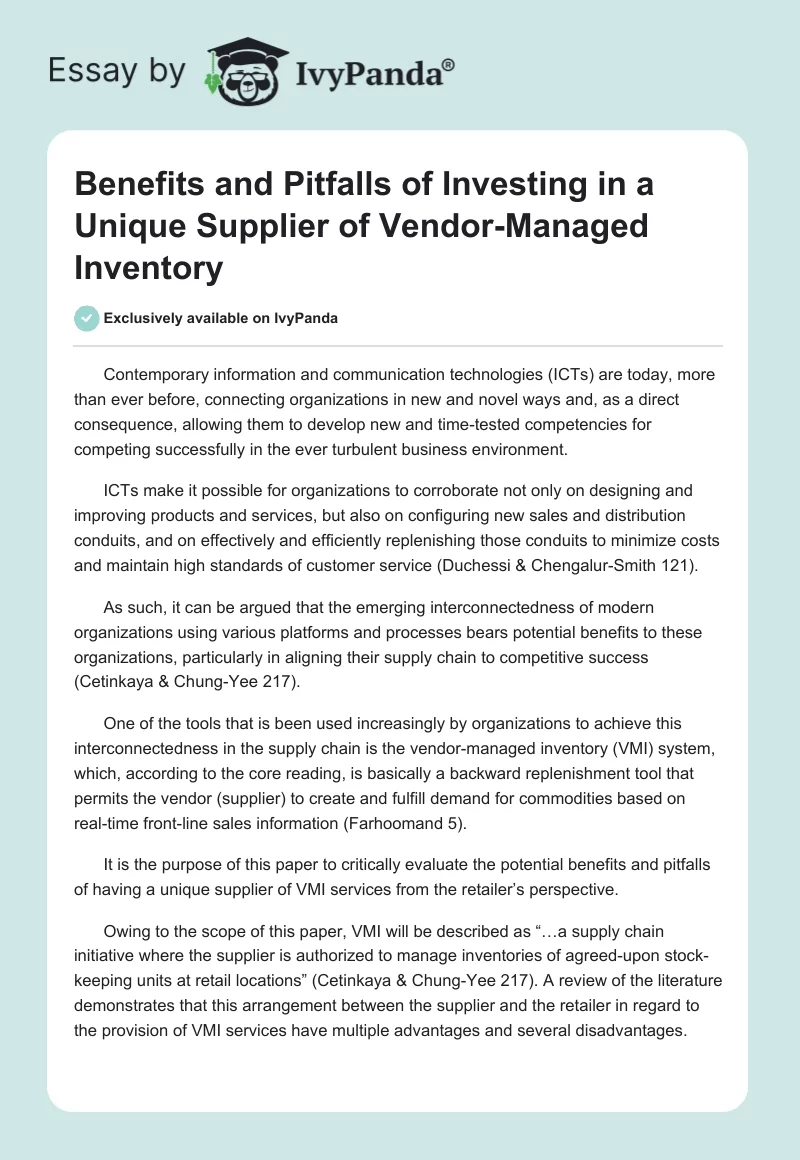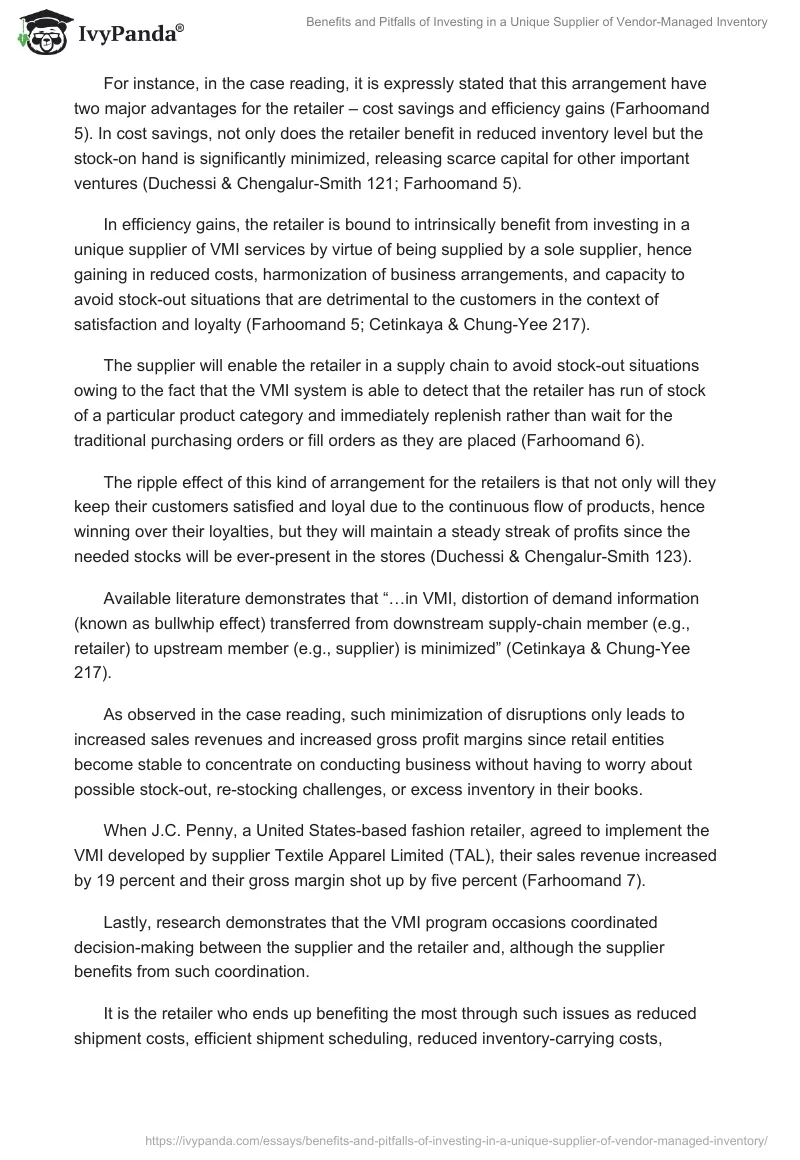Contemporary information and communication technologies (ICTs) are today, more than ever before, connecting organizations in new and novel ways and, as a direct consequence, allowing them to develop new and time-tested competencies for competing successfully in the ever turbulent business environment.
ICTs make it possible for organizations to corroborate not only on designing and improving products and services, but also on configuring new sales and distribution conduits, and on effectively and efficiently replenishing those conduits to minimize costs and maintain high standards of customer service (Duchessi & Chengalur-Smith 121).
As such, it can be argued that the emerging interconnectedness of modern organizations using various platforms and processes bears potential benefits to these organizations, particularly in aligning their supply chain to competitive success (Cetinkaya & Chung-Yee 217).
One of the tools that is been used increasingly by organizations to achieve this interconnectedness in the supply chain is the vendor-managed inventory (VMI) system, which, according to the core reading, is basically a backward replenishment tool that permits the vendor (supplier) to create and fulfill demand for commodities based on real-time front-line sales information (Farhoomand 5).
It is the purpose of this paper to critically evaluate the potential benefits and pitfalls of having a unique supplier of VMI services from the retailer’s perspective.
Owing to the scope of this paper, VMI will be described as “…a supply chain initiative where the supplier is authorized to manage inventories of agreed-upon stock-keeping units at retail locations” (Cetinkaya & Chung-Yee 217). A review of the literature demonstrates that this arrangement between the supplier and the retailer in regard to the provision of VMI services have multiple advantages and several disadvantages.
For instance, in the case reading, it is expressly stated that this arrangement have two major advantages for the retailer – cost savings and efficiency gains (Farhoomand 5). In cost savings, not only does the retailer benefit in reduced inventory level but the stock-on hand is significantly minimized, releasing scarce capital for other important ventures (Duchessi & Chengalur-Smith 121; Farhoomand 5).
In efficiency gains, the retailer is bound to intrinsically benefit from investing in a unique supplier of VMI services by virtue of being supplied by a sole supplier, hence gaining in reduced costs, harmonization of business arrangements, and capacity to avoid stock-out situations that are detrimental to the customers in the context of satisfaction and loyalty (Farhoomand 5; Cetinkaya & Chung-Yee 217).
The supplier will enable the retailer in a supply chain to avoid stock-out situations owing to the fact that the VMI system is able to detect that the retailer has run of stock of a particular product category and immediately replenish rather than wait for the traditional purchasing orders or fill orders as they are placed (Farhoomand 6).
The ripple effect of this kind of arrangement for the retailers is that not only will they keep their customers satisfied and loyal due to the continuous flow of products, hence winning over their loyalties, but they will maintain a steady streak of profits since the needed stocks will be ever-present in the stores (Duchessi & Chengalur-Smith 123).
Available literature demonstrates that “…in VMI, distortion of demand information (known as bullwhip effect) transferred from downstream supply-chain member (e.g., retailer) to upstream member (e.g., supplier) is minimized” (Cetinkaya & Chung-Yee 217).
As observed in the case reading, such minimization of disruptions only leads to increased sales revenues and increased gross profit margins since retail entities become stable to concentrate on conducting business without having to worry about possible stock-out, re-stocking challenges, or excess inventory in their books.
When J.C. Penny, a United States-based fashion retailer, agreed to implement the VMI developed by supplier Textile Apparel Limited (TAL), their sales revenue increased by 19 percent and their gross margin shot up by five percent (Farhoomand 7).
Lastly, research demonstrates that the VMI program occasions coordinated decision-making between the supplier and the retailer and, although the supplier benefits from such coordination.
It is the retailer who ends up benefiting the most through such issues as reduced shipment costs, efficient shipment scheduling, reduced inventory-carrying costs, effective stock replenishment, and improved utilization of scarce resources such as time and money (Bookbinder et al. 5550; Duchessi & Chengalur-Smith 125).
Coordinated decision-making is in indeed important in retail industry to maximize sales and reduce wastage (Cetinkaya & Chung-Yee 219).
In discussing the pitfalls, it is often thought that implementing an effective and efficient VMI is a costly affair for many cadres of retailers, particularly small-scale, mid-level and start-ups (Cetinkaya & Chung-Yee 228). Consequently, it can be deduced that such retailers will end up staying for a long time without experiencing the immense benefits offered by this platform.
The arrangement is also thought to lessen the control that retailers have over the products in their stores and warehouses since a supplier may feel he has the predominant right to introduce and test for market reception any product he wants without even seeking approval from the retailer (Duchessi & Chengalur 125).
However, this disadvantage should be construed as a perception as no enough evidence has been produced to support the assertion (Bookbinder et al. 5557).
Lastly, not only will competition between vendors (suppliers) hurt the retailers’ business when the different vendors compete for available shelf-space, but some retailers tie themselves up with cash flow problems when they enter into VMI relationships with some suppliers as they run the risk of permitting these suppliers to stock orders that are inarguably out of scale with what the retailers are capable of selling (Bookbinder et al 5565).
Works Cited
Bookbinder, James H., Gumus, Mehmet, & Jewkes, Elizabeth, M. “Calculating the Benefits of Vendor Managed Inventory in a Manufacturer-Retailer System.” International Journal of Production Research 48.19 (2010): 5549-5571.
Cetinkaya, Sila, & Lee, Chung-Yee. “Stock Replenishment and Shipment Scheduling for Vendor-Managed Inventory Systems.” Management Sciences 46.2 (2000): 217-232.
Duchessi, Peter, & Chengalur-Smith, Indoshobha. “Enhancing Business Performance: Via Vendor Managed Inventory Applications.” Communications of the ACM 51.12 (2008): 121-127.
Farhoomand, Ali. TAL Apparel Limited: Stepping up the Value Chain. Asia Case Research Centre, the University of Hong Kong. 2005.


